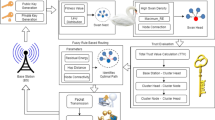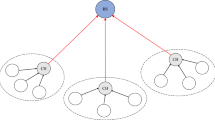Abstract
Mobile sensor networks consist of a set of mobile sensor nodes, which establish wireless communications within a specific area. In WSNs, mobile sensor nodes can sense the physical status of a given environment, process information and report them to the sink node or the base station. Due to nodes’ movements, these networks do not have a fixed infrastructure. There is no centralized controlling infrastructure for wireless sensor networks and different nodes are at relative liberty for joining and leaving network. Furthermore, due to the specific applications of these networks, it is highly probable that malicious nodes may exist in the network. The available malicious nodes in these networks do not follow the general principles, which dominate the execution of the routing protocols. They make hostile changes and abuse the rules, so as to disrupt the normal functioning of the routing protocols. In this way, malicious nodes aim to demolish the network or they refuse to cooperate fully with other available nodes in the network so that they can preserve their own limited energy. Consequently, they would like to destroy the possibility for providing services for some users. In order to ensure routing security in sensor networks and consider their fundamental challenge, i.e. nodes’ optimal power consumption, we proposed clustering-based secure routing protocol by capitalizing on willow butterfly algorithm. It has three phases, i.e. clustering, encryption and routing. The results of simulating the proposed method using OPNET showed its better performance in terms of power consumption, data transmission delay and access delay to media, data-packet loss rate by destructive nodes and productivity rate.











Similar content being viewed by others
Availability of Data and Materials
The data that support the findings of this study are available from the corresponding author upon reasonable request.
References
Wang, Y., Chen, J., Jin, Q., & Ma, J. (2016). Message forwarding strategies in device-to-device based mobile social networking in proximity (msnp). In 2016 IEEE 14th international conference on dependable, autonomic and secure computing, 14th international conference on pervasive intelligence and computing, 2nd international conference on big data intelligence and computing and cyber science and technology congress (DASC/PiCom/DataCom/CyberSciTech) (pp. 69–74). IEEE.
Li, P., & Lu, R. (2015). A sybil attack detection scheme for privacy-preserving mobile social networks. In 2015 10th international conference on information, communications and signal processing (ICICS) (pp. 1–5). IEEE.
Andreev, S., Hosek, J., Olsson, T., Johnsson, K., Pyattaev, A., Ometov, A., et al. (2016). A unifying perspective on proximity-based cellular-assisted mobile social networking. IEEE Communications Magazine, 54(4), 108–116.
Jeba, S. A., & Paramasivan, B. (2013). Energy efficient multipath data transfer scheme to mitigate false data injection attack in wireless sensor networks. Computers & Electrical Engineering, 39(6), 1867–1879.
Westin, A. F. (1968). Privacy and freedom. Washington and Lee Law Review, 25(1), 166.
Cutillo, L. A., Molva, R., & Strufe, T. (2009). Safebook: A privacy-preserving online social network leveraging on real-life trust. IEEE Communications Magazine, 47(12), 94–101.
Squicciarini, A. C., Xu, H., & Zhang, X. (2011). CoPE: Enabling collaborative privacy management in online social networks. Journal of the American Society for Information Science and Technology, 62(3), 521–534.
Hu, X., Chu, T. H., Leung, V. C., Ngai, E. C. H., Kruchten, P., & Chan, H. C. (2014). A survey on mobile social networks: Applications, platforms, system architectures, and future research directions. IEEE Communications Surveys & Tutorials, 17(3), 1557–1581.
Wu, D., Zhang, F., Wang, H., & Wang, R. (2018). Security-oriented opportunistic data forwarding in mobile social networks. Future Generation Computer Systems, 87, 803–815.
Heravi, A., Mubarak, S., & Choo, K. K. R. (2018). Information privacy in online social networks: Uses and gratification perspective. Computers in Human Behavior, 84, 441–459.
Tabatabaei, S., & Rigi, A. M. (2019). Reliable routing algorithm based on clustering and mobile sink in wireless sensor networks. Wireless Personal Communications, 108(4), 2541–2558.
Sharma, R., Vashisht, V., & Singh, U. (2019). Fuzzy modelling based energy aware clustering in wireless sensor networks using modified invasive weed optimization. Journal of King Saud University-Computer and Information Sciences.
Medková, J. (2018). Composition attack against social network data. Computers & Security, 74, 115–129.
Qiu, M., Gai, K., & Xiong, Z. (2018). Privacy-preserving wireless communications using bipartite matching in social big data. Future Generation Computer Systems, 87, 772–781.
Ometov, A., Levina, A., Borisenko, P., Mostovoy, R., Orsino, A., & Andreev, S. (2017). Mobile social networking under side-channel attacks: Practical security challenges. IEEE Access, 5, 2591–2601.
Qiu, T., Chen, B., Sangaiah, A. K., Ma, J., & Huang, R. (2017). A survey of mobile social networks: Applications, social characteristics, and challenges. IEEE Systems Journal, 12(4), 3932–3947.
Ortiz, J., Chih, W. H., & Tsai, F. S. (2018). Information privacy, consumer alienation, and lurking behavior in social networking sites. Computers in Human Behavior, 80, 143–157.
Wang, R., Rho, S., Chen, B. W., & Cai, W. (2017). Modeling of large-scale social network services based on mechanisms of information diffusion: Sina weibo as a case study. Future Generation Computer Systems, 74, 291–301.
Ma, X., Ma, J., Li, H., Jiang, Q., & Gao, S. (2018). ARMOR: A trust-based privacy-preserving framework for decentralized friend recommendation in online social networks. Future Generation Computer Systems, 79, 82–94.
Mazinani, A., Mazinani, S. M., & Hasanabadi, S. (2021). FSCVG: A fuzzy semi-distributed clustering using virtual grids in WSN. Wireless Personal Communications, 118(2), 1017–1038.
Maheswari, M., & Karthika, R. A. (2021). A novel QoS based secure unequal clustering protocol with intrusion detection system in wireless sensor networks. Wireless Personal Communications, 118(2), 1535–1557.
Singh, S., & Saini, H. S. (2021). Learning-based security technique for selective forwarding attack in clustered WSN. Wireless Personal Communications, 118(1), 789–814.
Kandhoul, N., & Dhurandher, S. K. (2021). An efficient and secure data forwarding mechanism for opportunistic IoT. Wireless Personal Communications, 118(1), 217–237.
Radhika, S., & Rangarajan, P. (2021). Fuzzy based sleep scheduling algorithm with machine learning techniques to enhance energy efficiency in wireless sensor networks. Wireless Personal Communications, 1–20.
Zardosht, M. J., & Parhizgar, N. (2021). Energy optimization in multi-hop wireless sensor networks based on proposed harmony search routing algorithm. Wireless Personal Communications, 1–15.
Wang, G. (2018). Moth search algorithm: A bio-inspired metaheuristic algorithm for global optimization problems. Memetic Comp., 10, 151–164.
Mirjalili, S. (2015). Moth-flame optimization algorithm: A novel nature-inspired heuristic paradigm. Knowledge-based systems, 89, 228–249.
Funding
This study has received no funding from any organizations.
Author information
Authors and Affiliations
Corresponding author
Ethics declarations
Conflicts of interest
All of the authors declare that they have no conflict of interest.
Ethical Approval
This article does not contain any studies with human participants or animals performed by any of the authors.
Consent to Participate
This article does not contain any studies with human participants or animals performed by any of the authors.
Consent for Publication
This article does not contain any studies with human participants or animals performed by any of the authors.
Code availability
All code for data analysis associated with the current submission is available from the corresponding author upon reasonable request.
Additional information
Publisher's Note
Springer Nature remains neutral with regard to jurisdictional claims in published maps and institutional affiliations.
Rights and permissions
About this article
Cite this article
Allahverdi Mamaghani, A., Ebrahimi Dishabi, M., Tabatabaei, S. et al. A Novel Clustering Protocol Based on Willow Butterfly Algorithm for Diffusing Data in Wireless Sensor Networks. Wireless Pers Commun 121, 3425–3450 (2021). https://doi.org/10.1007/s11277-021-08885-3
Accepted:
Published:
Issue Date:
DOI: https://doi.org/10.1007/s11277-021-08885-3




